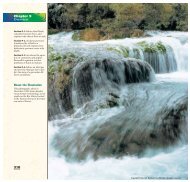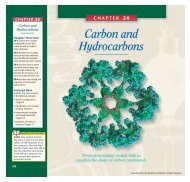Chapter 24 Seed Plant Structure and Growth Section 1
Chapter 24 Seed Plant Structure and Growth Section 1
Chapter 24 Seed Plant Structure and Growth Section 1
You also want an ePaper? Increase the reach of your titles
YUMPU automatically turns print PDFs into web optimized ePapers that Google loves.
Name ______________________________Class ________________________ Date _______________________<br />
<strong>Chapter</strong> Outline<br />
<strong>Chapter</strong> <strong>24</strong> <strong>Seed</strong> <strong>Plant</strong> <strong>Structure</strong> <strong>and</strong><br />
<strong>Growth</strong><br />
<strong>Section</strong> 1 1: <strong>Plant</strong> Tissue Systems<br />
KEY IDEAS<br />
> What three types of tissue are found in vascular plants?<br />
> What is the dermal tissue system?<br />
> What are two types of vascular tissue?<br />
> What is ground tissue?<br />
PLANT TISSUES<br />
> What three types of tissue are found in vascular plants?<br />
> Vascular plants have three tissue systems—the dermal tissue system, vascular tissue<br />
system, <strong>and</strong> ground tissue system.<br />
• Dermal tissue forms the protective outer layer of a plant.<br />
• Vascular tissue forms str<strong>and</strong>s that conduct water, minerals, <strong>and</strong> organic compounds<br />
throughout a vascular plant.<br />
• Ground tissue makes up much of the inside of the nonwoody parts of a plant,<br />
including roots, stems, <strong>and</strong> leaves.<br />
DERMAL TISSUE SYSTEM<br />
> What is the dermal tissue system?<br />
> Dermal tissue covers the outside of a plant’s body. In the nonwoody parts of a plant,<br />
dermal tissue forms a “skin” called epidermis.<br />
• Extensions of the epidermal cells on root tips, called root hairs, help increase water<br />
absorption.<br />
• A waxy cuticle coats the epidermis of stems <strong>and</strong> leaves.<br />
– The cuticle protects the plant <strong>and</strong> prevents water loss.<br />
• Pores called stomata (singular, stoma) permit plants to exchange oxygen <strong>and</strong> carbon<br />
dioxide.<br />
– A pair of specialized cells called guard cells borders each stoma.<br />
– Stomata open <strong>and</strong> close as the guard cells change shape.<br />
• In addition to its role in protection, dermal tissue functions in gas exchange <strong>and</strong> in the<br />
absorption of mineral nutrients.<br />
Original content Copyright © by Holt, Rinehart <strong>and</strong> Winston. Additions <strong>and</strong> changes to the original content are the responsibility of the instructor.<br />
Holt Biology 1 <strong>Seed</strong> <strong>Plant</strong> <strong>Structure</strong> <strong>and</strong> <strong>Growth</strong>
Name ______________________________Class ________________________ Date _______________________<br />
<strong>Seed</strong> <strong>Plant</strong> <strong>Structure</strong> <strong>and</strong> <strong>Growth</strong> continued<br />
VASCULAR TISSUE SYSTEM<br />
> What are two types of vascular tissue?<br />
> Vascular plants have two kinds of vascular tissue, called xylem <strong>and</strong> phloem, that transport<br />
water, minerals, <strong>and</strong> nutrients throughout the plant.<br />
• These tissues are composed of cells that are stacked end to end like sections of pipe.<br />
• Xylem <strong>and</strong> phloem allow most vascular plants to grow to much larger sizes than<br />
nonvascular plants, which do not have xylem <strong>and</strong> phloem.<br />
• Xylem is composed of thick-walled cells that provide support <strong>and</strong> conduct water <strong>and</strong><br />
mineral nutrients from a plant’s roots through its stems to its leaves.<br />
• Phloem is made up of cells that conduct sugars <strong>and</strong> nutrients throughout a plant’s<br />
body.<br />
GROUND TISSUE SYSTEM<br />
> What is ground tissue?<br />
> Ground tissue makes up much of the inside of most nonwoody plants, where it surrounds<br />
<strong>and</strong> supports vascular tissue.<br />
• Ground tissue contains many cell types, each with specific functions based on where<br />
the cells are located in a plant.<br />
– In leaves, the ground tissue is composed of cells that are packed with chloroplasts.<br />
These cells are specialized for photosynthesis.<br />
– The ground tissue in stems <strong>and</strong> roots functions mainly in support <strong>and</strong> in the<br />
storage of water, sugar, <strong>and</strong> starch.<br />
Original content Copyright © by Holt, Rinehart <strong>and</strong> Winston. Additions <strong>and</strong> changes to the original content are the responsibility of the instructor.<br />
Holt Biology 2 <strong>Seed</strong> <strong>Plant</strong> <strong>Structure</strong> <strong>and</strong> <strong>Growth</strong>
Name ______________________________Class ________________________ Date _______________________<br />
<strong>Seed</strong> <strong>Plant</strong> <strong>Structure</strong> <strong>and</strong> <strong>Growth</strong> continued<br />
<strong>Section</strong> 2: Roots, Stems, <strong>and</strong> Leaves<br />
KEY IDEAS<br />
> What are roots, <strong>and</strong> what is their function?<br />
> What are stems, <strong>and</strong> what is their function?<br />
> What are leaves, <strong>and</strong> what is their function?<br />
ROOTS<br />
> What are roots, <strong>and</strong> what is their function?<br />
> Most plants are anchored to the spot where they grow by roots, which absorb water <strong>and</strong><br />
mineral nutrients. In many plants, roots also function in the storage of organic nutrients,<br />
such as sugar <strong>and</strong> starch.<br />
• Most monocots, such as grasses, have a highly branched, fibrous root system.<br />
• Many dicots, such as d<strong>and</strong>elions <strong>and</strong> radishes, have a large central root from which<br />
smaller roots branch. This type of system is called a taproot system.<br />
• A root has a central core of vascular tissue that is surrounded by ground tissue. The<br />
ground tissue surrounding the vascular tissue is called the cortex.<br />
• Roots are covered by dermal tissue.<br />
STEMS<br />
> What are stems, <strong>and</strong> what is their function?<br />
> Stems support the leaves <strong>and</strong> house the vascular tissue, which transports substances<br />
between the roots <strong>and</strong> the leaves.<br />
• Many plants have stems that are specialized for other functions, such as water storage<br />
in cactus.<br />
• A plant with stems that are flexible <strong>and</strong> usually green is called a herbaceous plant.<br />
– The stems of herbaceous plants contain bundles of xylem <strong>and</strong> phloem called<br />
vascular bundles.<br />
– Vascular bundles are surrounded by ground tissue. The tissue at the center of the<br />
stem of most vascular plants is called the pith.<br />
– The pith is used for storage.<br />
• Woody stems, such as those of trees <strong>and</strong> shrubs, are stiff <strong>and</strong> nongreen.<br />
– The wood in the center of a mature stem or tree trunk is called heartwood.<br />
– Sapwood, which lies outside the heartwood, contains vessel elements that can<br />
conduct water.<br />
Original content Copyright © by Holt, Rinehart <strong>and</strong> Winston. Additions <strong>and</strong> changes to the original content are the responsibility of the instructor.<br />
Holt Biology 3 <strong>Seed</strong> <strong>Plant</strong> <strong>Structure</strong> <strong>and</strong> <strong>Growth</strong>
Name ______________________________Class ________________________ Date _______________________<br />
<strong>Seed</strong> <strong>Plant</strong> <strong>Structure</strong> <strong>and</strong> <strong>Growth</strong> continued<br />
LEAVES<br />
> What are leaves, <strong>and</strong> what is their function?<br />
> Leaves are the primary photosynthetic organs of plants.<br />
• Most leaves have a flattened portion, the blade, which is usually attached to a stem by<br />
a stalk, called the petiole.<br />
– A leaf blade may be divided into two or more sections, called leaflets.<br />
• A leaf is a mass of ground <strong>and</strong> vascular tissue covered by epidermis.<br />
– A cuticle coats the upper <strong>and</strong> lower epidermis.<br />
– Both xylem <strong>and</strong> phloem are found in the veins of a leaf. Veins are extensions of<br />
vascular bundles that run from the tips of roots to the edge of leaves.<br />
• In leaves, the ground tissue is called mesophyll.<br />
– Mesophyll cells are packed with chloroplasts, where photosynthesis occurs.<br />
– One or more rows of closely packed, columnar cells make up the palisade layer,<br />
which lies just beneath the upper epidermis.<br />
• Many plants have modified leaves that are specialized for particular functions.<br />
– For example, water lily leaves are specialized for floating on the surface of ponds.<br />
– Cactus spines are modified leaves.<br />
– Venus’ flytrap leaves are modified to catch insects.<br />
Original content Copyright © by Holt, Rinehart <strong>and</strong> Winston. Additions <strong>and</strong> changes to the original content are the responsibility of the instructor.<br />
Holt Biology 4 <strong>Seed</strong> <strong>Plant</strong> <strong>Structure</strong> <strong>and</strong> <strong>Growth</strong>
Name ______________________________Class ________________________ Date _______________________<br />
<strong>Seed</strong> <strong>Plant</strong> <strong>Structure</strong> <strong>and</strong> <strong>Growth</strong> continued<br />
<strong>Section</strong> 3: <strong>Plant</strong> <strong>Growth</strong> <strong>and</strong> Development<br />
KEY IDEAS<br />
> What are the characteristics of a seed plant embryo?<br />
> How do meristems relate to plant growth?<br />
> What is the result of primary growth on a plant?<br />
> What is secondary growth, <strong>and</strong> what type of meristem is involved?<br />
THE PLANT EMBRYO<br />
> What are the characteristics of a seed plant embryo?<br />
> The plant embryo possesses an embryonic root <strong>and</strong> an embryonic shoot. Leaflike<br />
structures called cotyledons, or seed leaves, are attached to the embryonic shoot.<br />
• A seed develops from an ovule <strong>and</strong> contains a plant embryo.<br />
• In angiosperms (flowering plants), embryos have one or two cotyledons.<br />
– Monocots have a single cotyledon, <strong>and</strong> dicots have two cotyledons.<br />
• The process by which a plant embryo resumes its growth after a period of suspended<br />
animation, or dormancy, is called germination.<br />
• <strong>Seed</strong>s sprout in response to certain changes in the environment.<br />
– Changes such as rising temperature <strong>and</strong> increasing soil moisture usually signal the<br />
start of favorable growing conditions.<br />
– Some seeds must be exposed to cold, fire, or damage before they can sprout.<br />
MERISTEMS<br />
> How do meristems relate to plant growth?<br />
> <strong>Plant</strong>s grow by producing new cells in regions of active cell division called meristems.<br />
• Meristems are made up of undifferentiated cells that divide <strong>and</strong> can develop into<br />
specialized tissues.<br />
• <strong>Growth</strong> that increases the length or height of a plant is called primary growth.<br />
– The tissues that result from primary growth are primary tissues.<br />
• <strong>Growth</strong> that increases the width of stems <strong>and</strong> roots is called secondary growth.<br />
– The tissues that result from secondary growth are secondary tissues.<br />
Original content Copyright © by Holt, Rinehart <strong>and</strong> Winston. Additions <strong>and</strong> changes to the original content are the responsibility of the instructor.<br />
Holt Biology 5 <strong>Seed</strong> <strong>Plant</strong> <strong>Structure</strong> <strong>and</strong> <strong>Growth</strong>
Name ______________________________Class ________________________ Date _______________________<br />
<strong>Seed</strong> <strong>Plant</strong> <strong>Structure</strong> <strong>and</strong> <strong>Growth</strong> continued<br />
PRIMARY GROWTH<br />
> What is the result of primary growth on a plant?<br />
> Primary growth makes a plant’s stems <strong>and</strong> roots get longer without becoming wider.<br />
• Apical meristems, which are located at the tips of stems <strong>and</strong> roots, produce primary<br />
growth through cell division.<br />
• The new cells produced by apical meristems differentiate into the primary tissues of<br />
roots, stems, <strong>and</strong> leaves.<br />
• Each branch of a stem <strong>and</strong> each branch of a root has its own apical meristem that<br />
produces new primary tissues as the branch grows.<br />
SECONDARY GROWTH<br />
> What is secondary growth, <strong>and</strong> what type of meristem is involved?<br />
> Lateral meristems are responsible for increases in the width of stems <strong>and</strong> roots. This<br />
increase is called secondary growth.<br />
• Some of the undifferentiated cells that are left behind as stems <strong>and</strong> roots lengthen <strong>and</strong><br />
produce lateral meristems.<br />
• The two lateral meristems responsible for secondary growth are called the cork<br />
cambium <strong>and</strong> the vascular cambium.<br />
Original content Copyright © by Holt, Rinehart <strong>and</strong> Winston. Additions <strong>and</strong> changes to the original content are the responsibility of the instructor.<br />
Holt Biology 6 <strong>Seed</strong> <strong>Plant</strong> <strong>Structure</strong> <strong>and</strong> <strong>Growth</strong>

















